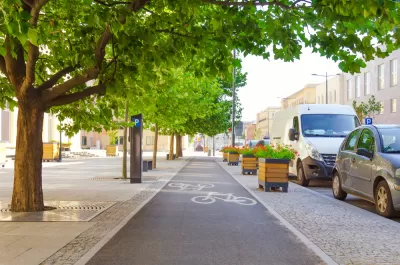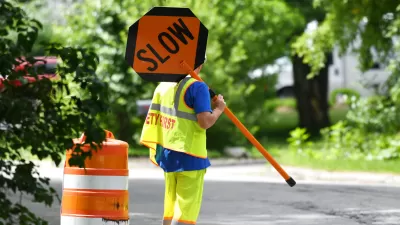A bill named in honor of a U.S. diplomat killed while on her bicycle would let state DOTs access full federal funding for road safety projects.

A federal list of road design elements called “proven safety countermeasures” could hold the key to improved road safety, says former Federal Highway Administration Administrator Shailen Bhatt.
As Kea Wilson explains in Streetsblog USA, “these measures offer safety benefits that have been meticulously proven and quantified by U.S. DOT itself, in the hyper-specific contexts in which traffic engineers might use them — a far higher and more important bar to clear in the bureaucratic world of state DOTs.”
Currently, state DOTs must offer a 10 percent match to receive federal funding for safety projects, meaning they’re often deprioritized in states with low resources. A proposed bill, the Sarah Debbink Langenkamp Act, would allow state DOTs to use 100 percent federal money for safety measures, eliminating the 10 percent local match. “Even as America enters an uncertain new era, supporters of the Langenkamp bill say strategies like protected bike lanes are becoming increasingly normalized in the minds of American transportation officials, thanks in no small part to their status as a proven safety countermeasures.”
According to Wilson, “Increasing state control over how communities make their roads safer is a message that advocates hope a GOP-held Congress can get behind — especially since the bill wouldn't touch a separate federal law that prohibits states from spending more than 10 percent of their total safety money on projects for which the federal government is paying 100 percent of the cost.”
FULL STORY: One Hidden Reason Why Your State DOT Isn’t Building Protected Bike Lanes

Maui's Vacation Rental Debate Turns Ugly
Verbal attacks, misinformation campaigns and fistfights plague a high-stakes debate to convert thousands of vacation rentals into long-term housing.

Planetizen Federal Action Tracker
A weekly monitor of how Trump’s orders and actions are impacting planners and planning in America.

San Francisco Suspends Traffic Calming Amidst Record Deaths
Citing “a challenging fiscal landscape,” the city will cease the program on the heels of 42 traffic deaths, including 24 pedestrians.

Defunct Pittsburgh Power Plant to Become Residential Tower
A decommissioned steam heat plant will be redeveloped into almost 100 affordable housing units.

Trump Prompts Restructuring of Transportation Research Board in “Unprecedented Overreach”
The TRB has eliminated more than half of its committees including those focused on climate, equity, and cities.

Amtrak Rolls Out New Orleans to Alabama “Mardi Gras” Train
The new service will operate morning and evening departures between Mobile and New Orleans.
Urban Design for Planners 1: Software Tools
This six-course series explores essential urban design concepts using open source software and equips planners with the tools they need to participate fully in the urban design process.
Planning for Universal Design
Learn the tools for implementing Universal Design in planning regulations.
Heyer Gruel & Associates PA
JM Goldson LLC
Custer County Colorado
City of Camden Redevelopment Agency
City of Astoria
Transportation Research & Education Center (TREC) at Portland State University
Jefferson Parish Government
Camden Redevelopment Agency
City of Claremont





























